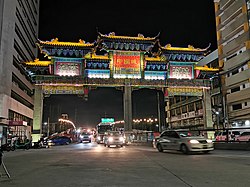
Back Binondo BCL Binondo Spanish Binondo ILO Binondo Italian Binondo Malay Binondo Dutch Binondo PAM Бинондо Russian Binondo Tagalog Binondo Vietnamese
This article needs additional citations for verification. (December 2023) |
Binondo | |
|---|---|
Constituent and Central Business District of Manila | |
| Other transcription(s) | |
| • Chinese | 岷倫洛 |
 Filipino-Chinese Friendship Arch | |
| Nickname: | |
 Location within Manila | |
| Country | Philippines |
| Region | National Capital Region |
| City | Manila |
| Congressional District | Part of 3rd District of Manila |
| Barangays | 10 |
| Founded | 1594 |
| Founded by | Luis Pérez Dasmariñas |
| Area | |
| • Total | 0.66 km2 (0.26 sq mi) |
| Population (2020[1]) | |
| • Total | 20,491 |
| • Density | 31,000/km2 (79,000/sq mi) |
| Time zone | UTC+08:00 (Philippine Standard Time) |
| Zip codes | 1006 |
| Area codes | 2 |
| Languages | Hokkien Tagalog Mandarin |
| Binondo | |||||||||||||||||||||||||
|---|---|---|---|---|---|---|---|---|---|---|---|---|---|---|---|---|---|---|---|---|---|---|---|---|---|
| Traditional Chinese | 岷倫洛區 | ||||||||||||||||||||||||
| Simplified Chinese | 岷伦洛区 | ||||||||||||||||||||||||
| |||||||||||||||||||||||||
Binondo (Chinese: 岷倫洛; pinyin: Mínlúnluò; Pe̍h-ōe-jī: Bîn-lûn-lo̍h) is a district in Manila and is referred to as the city's Chinatown.[2] Its influence extends beyond to the places of Quiapo, Santa Cruz, San Nicolas and Tondo. It is the oldest Chinatown in the world, established in 1594[3][4][5][6] by the Spaniards as a settlement near Intramuros but across the Pasig River for Catholic Chinese; it was positioned so that the colonial administration could keep a close eye on their migrant subjects.[7] It was already a hub of Chinese commerce even before the Spanish colonial period. Binondo is the center of commerce and trade of Manila, where all types of business run by Filipino-Chinese thrive.
Noted residents include Saint Lorenzo Ruiz, the Filipino protomartyr, and Venerable Mother Ignacia del Espiritu Santo, founder of the Congregation of the Religious of the Virgin Mary.
- ^ "Highlights of the National Capital Region (NCR) Population 2020 Census of Population and Housing (2020 CPH)". Philippine Statistics Authority. Retrieved November 14, 2021.
- ^ New discoveries in the world's oldest Chinatown GMA news
- ^ Geni Raitisoja (July 8, 2006). "Chinatown Manila: Oldest in the world". Archived from the original on March 27, 2012. Retrieved January 12, 2015.
- ^ Wherry, Frederick F. (September 1, 2015). The SAGE Encyclopedia of Economics and Society. SAGE Publications, Inc. p. 355. ISBN 9781452226439. Retrieved August 4, 2020.
- ^ Umali, Justin (February 4, 2019). "How Binondo Became the World's Oldest Chinatown". Esquire. Summit Media. Retrieved August 4, 2020.
- ^ Bernard P. Wong; Chee-Beng Tan (March 21, 2013). Chinatowns around the World: Gilded Ghetto, Ethnopolis, and Cultural Diaspora. Brill Publishers. p. 272. ISBN 9789004255906. Retrieved August 4, 2020.
- ^ Simon Ostheimer (September 12, 2012). "World's best Chinatowns". Retrieved January 12, 2015.[dead link]
© MMXXIII Rich X Search. We shall prevail. All rights reserved. Rich X Search